Pavement Performance and Ice-Melting Characteristics of Asphalt Mixtures Incorporating Slow-Release Deicing Agent
Abstract
1. Introduction
2. Materials and Methods
2.1. Materials
2.2. Mixture Design
2.3. Pavement Performance Tests
2.3.1. High-Temperament Performance Test
2.3.2. Low-Temperament Performance Test
2.3.3. Moisture Stability Test
2.4. Deicing Performance Tests
2.4.1. Ice-Melting Rate Test
2.4.2. Interface Adhesion Test
2.4.3. Solution Conductivity Test
2.5. Durability Prediction of Deicing Mixture
2.5.1. Ice-Melting Ability Test
2.5.2. Immersion Test
- (1)
- Marshall specimen with 50% deicing agent content was placed in a container, and 600 mL pure water was injected to soak the top of the specimen slightly;
- (2)
- After soaking for 24 h, the electrical conductivity of the solution was measured and recorded;
- (3)
- The same volume of pure water was replaced and soaked again, and the cycle was repeated until the measured conductivity was lower than the critical value.
3. Results and Discussion
3.1. Analysis of Pavement Performance
3.1.1. High-Temperature Performance
3.1.2. Low-Temperature Performance
3.1.3. Water Stability Performance
3.2. Analysis of Anti-Freezing Performance
3.2.1. Ice-Melting Rate
3.2.2. Interface Adhesion
3.2.3. Conductivity of Immersion Solution
3.3. Durability Prediction
3.3.1. Ice-Melting Ability of Gradient Concentration Solution
3.3.2. Durability Prediction of Deicing Agent
4. Conclusions
- (1)
- The high-temperature performance and low-temperature cracking resistance of the asphalt mixture continuously decrease with the increasing content of the deicing agent. The replacement of mineral filler with a deicing agent can enhance the Marshall stability of the mixture in the short term, while the long-term residual stability after the release of the active ingredient is lower than that of the ordinary mixture.
- (2)
- Deicing asphalt mixture can significantly improve the melting and snow removal ability of pavement. The interface adhesion can be reduced by more than 55% with a 50% replacement quantity. Considering the deicing performance and pavement performance of the mixture, the recommended replacement amount of slow-release deicing agent is found to be 50%.
- (3)
- The slow-release deicing asphalt mixture can reach the maximum release concentration in 2 h under rain and snow, after which the solution maintains a stable concentration.
- (4)
- The ice-melting capacity of the slow-release deicing agent is positively correlated with the released concentration. The effective life span of the deicing agent for this study is estimated to be 5–8 years after equivalent conversion.
Author Contributions
Funding
Data Availability Statement
Conflicts of Interest
References
- Zheng, M.L.; Wu, S.J.; Wang, C.T.; Li, Y.F.; Ma, Z.H.; Peng, L. A Study on Evaluation and Application of Snowmelt Performance of Anti-Icing Asphalt Pavement. Appl. Sci. 2017, 7, 583. [Google Scholar] [CrossRef]
- Zhao, W.K.; Li, L.; Wang, W.; Zhang, Y.N.; Su, W.T.; Chen, X.; Li, B.X. Thermal performances of porous snow by a hydronic heating system at different weather conditions. J. Therm. Anal. Calorim. 2020, 141, 1519–1528. [Google Scholar] [CrossRef]
- Arvidsson, A.K. The Winter Model—A new way to calculate socio-economic costs depending on winter maintenance strategy. Cold Reg. Sci. Technol. 2017, 136, 30–36. [Google Scholar] [CrossRef]
- Liu, K.; Fu, C.L.; Xie, H.Z.; Wang, F.; Wang, X.C.; Bai, H.J. Design of electric heat pipe embedding schemes for snow-melting pavement based on mechanical properties in cold regions. Cold Reg. Sci. Technol. 2019, 165, 102806. [Google Scholar] [CrossRef]
- Xia, Y.F.; Jia, J.; Chen, Q. Road Performance and Ice-Melting Characteristics of Steel Wool Asphalt Mixture. Adv. Civ. Eng. 2022, 2022, 7029176. [Google Scholar] [CrossRef]
- Wang, Z.J.; Zhang, T.; Shao, M.Y.; Ai, T.; Zhao, P. Investigation on snow-melting performance of asphalt mixtures incorporating with salt-storage aggregates. Constr. Build. Mater. 2017, 142, 187–198. [Google Scholar] [CrossRef]
- Zhang, Z.; Luo, Y.; Zhao, F. Review of research on the effect of salt storage deicing material on the preformance of asphalt mixture. Chem. Ind. Eng. Prog. 2018, 37, 2282–2294. [Google Scholar]
- Wu, S.Y.; Yang, J.; Yang, R.C.; Zhu, J.P.; Liu, S.; Wang, C.Y. Investigation of microscopic air void structure of anti-freezing asphalt pavement with X-ray CT and MIP. Constr. Build. Mater. 2018, 178, 473–483. [Google Scholar] [CrossRef]
- Li, F.; Wang, Z. Experiment of Road Performance of Asphalt Mixture with Automatic Long-term Snowmelt Agent. J. Highw. Transp. Res. Dev. 2012, 29, 7. [Google Scholar] [CrossRef]
- Xia, H.Y.; Zhao, X.; Wu, Y.C.; Yuan, T.; Song, L.F.; Yan, M.J.; Wang, F.Y.; Chen, H.X. Preparation and performance of antifreeze adhesive materials for asphalt pavement. Constr. Build. Mater. 2020, 258, 119554. [Google Scholar] [CrossRef]
- Zhao, Y.; Chen, C.; Xiang, Y.K.; Wang, J. Preparation, Characterization, and Anti-Icing Properties of Sustained-Release Low-Freezing-Point Asphalt Mixture. J. Mater. Civ. Eng. 2022, 34, 04022171. [Google Scholar] [CrossRef]
- Chen, H.X.; Wu, Y.C.; Xia, H.Y.; Zhang, Z.; Yuan, T. Anti-freezing asphalt concrete: Ice-adhesion performance. J. Mater. Sci. 2018, 53, 4781–4795. [Google Scholar] [CrossRef]
- Giuliani, F.; Merusi, F.; Polacco, G.; Filippi, S.; Paci, M. Effectiveness of of sodium chloride-based anti-icing filler in asphalt mixtures. Constr. Build. Mater. 2012, 30, 174–179. [Google Scholar] [CrossRef]
- Ma, T.; Geng, L.; Ding, X.H.; Zhang, D.Y.; Huang, X.M. Experimental study of deicing asphalt mixture with anti-icing additives. Constr. Build. Mater. 2016, 127, 653–662. [Google Scholar] [CrossRef]
- Xu, O.M.; Han, S.; Zhang, C.L.; Liu, Y.M.; Xiao, F.P.; Xu, J. Laboratory investigation of andesite and limestone asphalt mixtures containing sodium chloride-based anti-icing filler. Constr. Build. Mater. 2015, 98, 671–677. [Google Scholar] [CrossRef]
- Tan, Y.; Zhang, C.; Xu, H.; Tian, D. Snow Melting and Deicing Characteristics and Pavement Performance of Active Deicing and Snow Melting Pavement. China J. Highw. Transp. 2019, 32, 1–17. [Google Scholar]
- Han, S.; Yin, Y.Y.; Peng, B.A.; Dong, S.A.; Wu, S. Experimental Study of Asphalt Mixture with Acetate Anti-Icing Filler. Arab. J. Sci. Eng. 2022, 47, 4225–4237. [Google Scholar] [CrossRef]
- Liu, Z.Z.; Sha, A.M.; Xing, M.L.; Li, Z.Z. Low temperature property and salt releasing characteristics of antifreeze asphalt concrete under static and dynamic conditions. Cold Reg. Sci. Technol. 2015, 114, 9–14. [Google Scholar] [CrossRef]
- Ma, T.; Ding, X.H.; Wang, H.; Zhang, W.G. Experimental Study of High-Performance Deicing Asphalt Mixture for Mechanical Performance and Anti-Icing Effectiveness. J. Mater. Civ. Eng. 2018, 30, 04018180. [Google Scholar] [CrossRef]
- Min, Z.H.; Xia, Y.Y.; Li, X.C.; Tao, Z. Performances evaluation of epoxy asphalt mixture containing snow-melting agent. Constr. Build. Mater. 2017, 155, 762–769. [Google Scholar] [CrossRef]
- Yu, W.; Zhang, X.; Zhong, K. De-icing performance of asphalt mixture with snowmeltagent and high-elastic modified asphalt binder. J. China Univ. Min. Technol. 2015, 44, 912–916. [Google Scholar]
- Zhong, K.; Sun, M.Z.; Chang, R.H. Performance evaluation of high-elastic/salt-storage asphalt mixture modified with Mafilon and rubber particles. Constr. Build. Mater. 2018, 193, 153–161. [Google Scholar] [CrossRef]
- Zhou, J.; Li, J.; Liu, G.Q.; Yang, T.; Zhao, Y.L. Long-Term Performance and Deicing Effect of Sustained-Release Snow Melting Asphalt Mixture. Adv. Civ. Eng. 2019, 2019, 1940692. [Google Scholar] [CrossRef]
- Dan, H.C.; Tan, J.W.; Du, Y.F.; Cai, J.M. Simulation and optimization of road deicing salt usage based on Water-Ice-Salt Model. Cold Reg. Sci. Technol. 2020, 169, 102917. [Google Scholar] [CrossRef]
- Tian, M.M.; Zhu, B.L.; Cao, Y.H.; Jiang, R.N.; Yan, S.X. Anti-icing Capacity and Service Life Research on the Controlled Released Anti-icing Asphalt Modifier. In Proceedings of the 7th International Conference on Mechanical and Electronics Engineering (ICMEE), Dalian, China, 26–27 September 2015. [Google Scholar]
- Zhang, H.H.; Guo, R.H. Investigation of Long-Term Performance and Deicing Longevity Prediction of Self-Ice-Melting Asphalt Pavement. Materials 2022, 15, 6026. [Google Scholar] [CrossRef]
- Wu, S.Y.; Yang, J.; Sun, X.Y.; Wang, C.Y.; Yang, R.C.; Zhu, J.P. Preparation and characterization of anti-freezing asphalt pavement. Constr. Build. Mater. 2020, 236, 117579. [Google Scholar] [CrossRef]
- JTG F40-2019; Technical Specifications for Construction of Highway Asphalt Pavement. China Ministry of Transport: Beijing, China, 2019.
- JTG E20-2019; Standard Test Methods of Bitumen and Bituminous Mixtures for Highway Engineering. China Ministry of Transport: Beijing, China, 2019.
- JTG D50-2017; Specifications for Desigen of Highway Asphalt Pavement. China Ministry of Transport: Beijing, China, 2017.
- Li, L.M.; Li, H.Z.; Tan, Y.Q.; Yang, X.; Xu, H.N. Investigation of chloride release characteristic of Chlorine-Based Anti-Icing asphalt mixture. Constr. Build. Mater. 2021, 312, 125410. [Google Scholar] [CrossRef]
- Qin, K.; Ma, Q.; Wu, J. Research on Performance of Asphalt Concrete Under the Action of Temperature and Salt Corrosion. Bull. Chin. Ceram. Soc. 2013, 32, 952–956. [Google Scholar]
- Zhang, J.P.; Li, X.Q.; Liu, G.Q.; Pei, J.Z. Effects of material characteristics on asphalt and filler interaction ability. Int. J. Pavement Eng. 2019, 20, 928–937. [Google Scholar] [CrossRef]
- Liu, Z.Z.; Xing, M.L.; Chen, S.F.; He, R.; Cong, P.L. Influnence of the chloride-based anti-freeze filler on the properties of asphalt mixture. Constr. Build. Mater. 2014, 51, 133–140. [Google Scholar] [CrossRef]
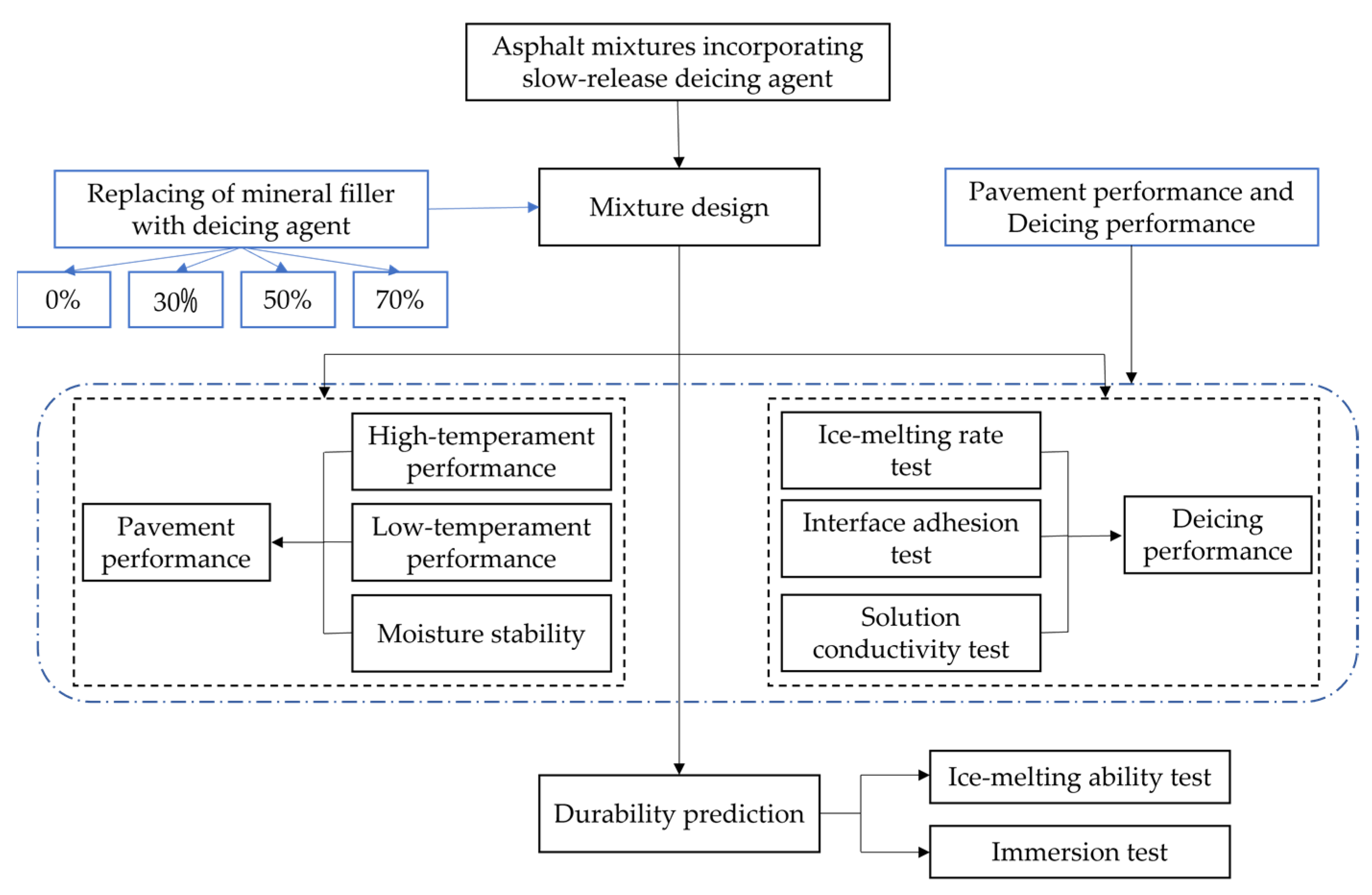
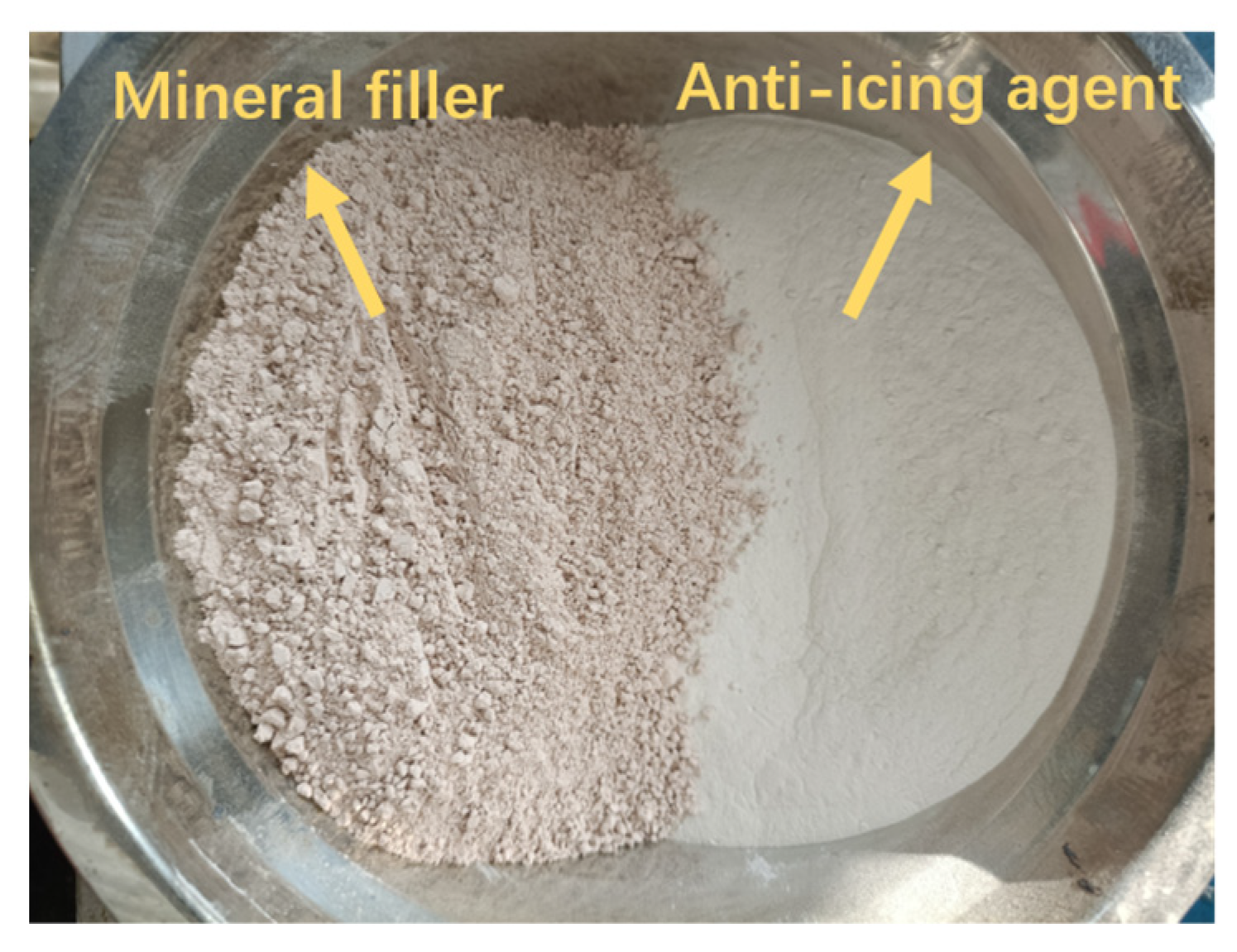

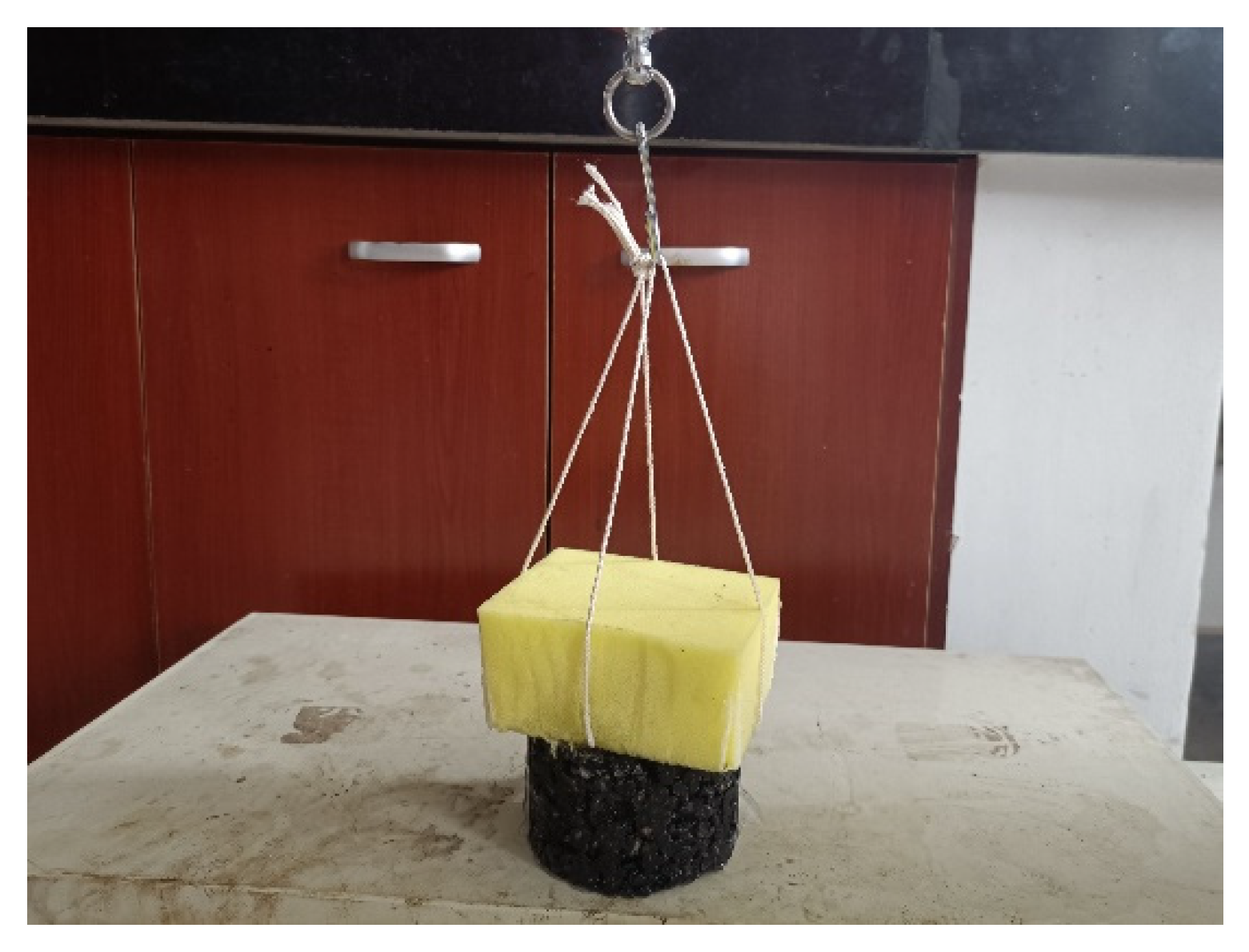
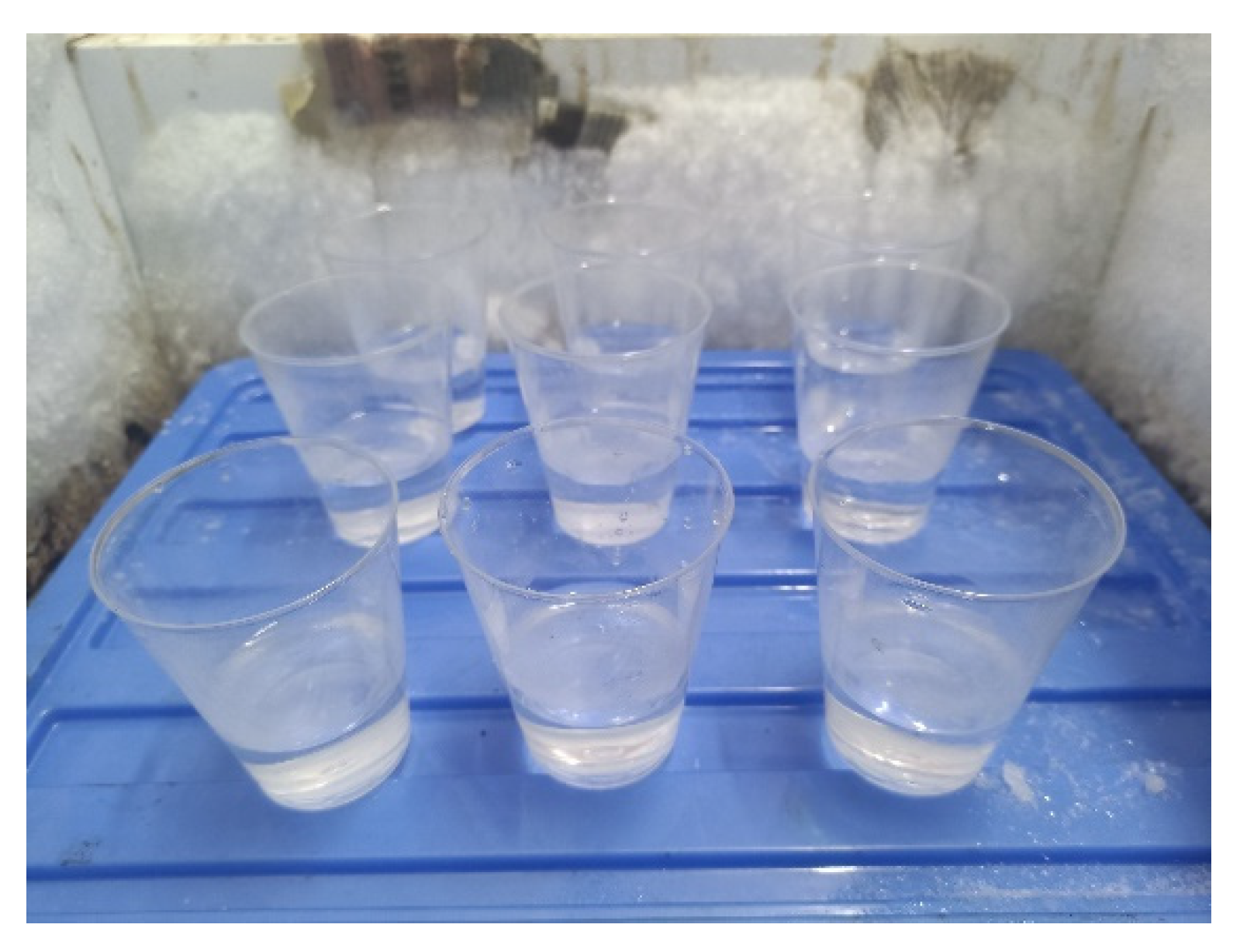
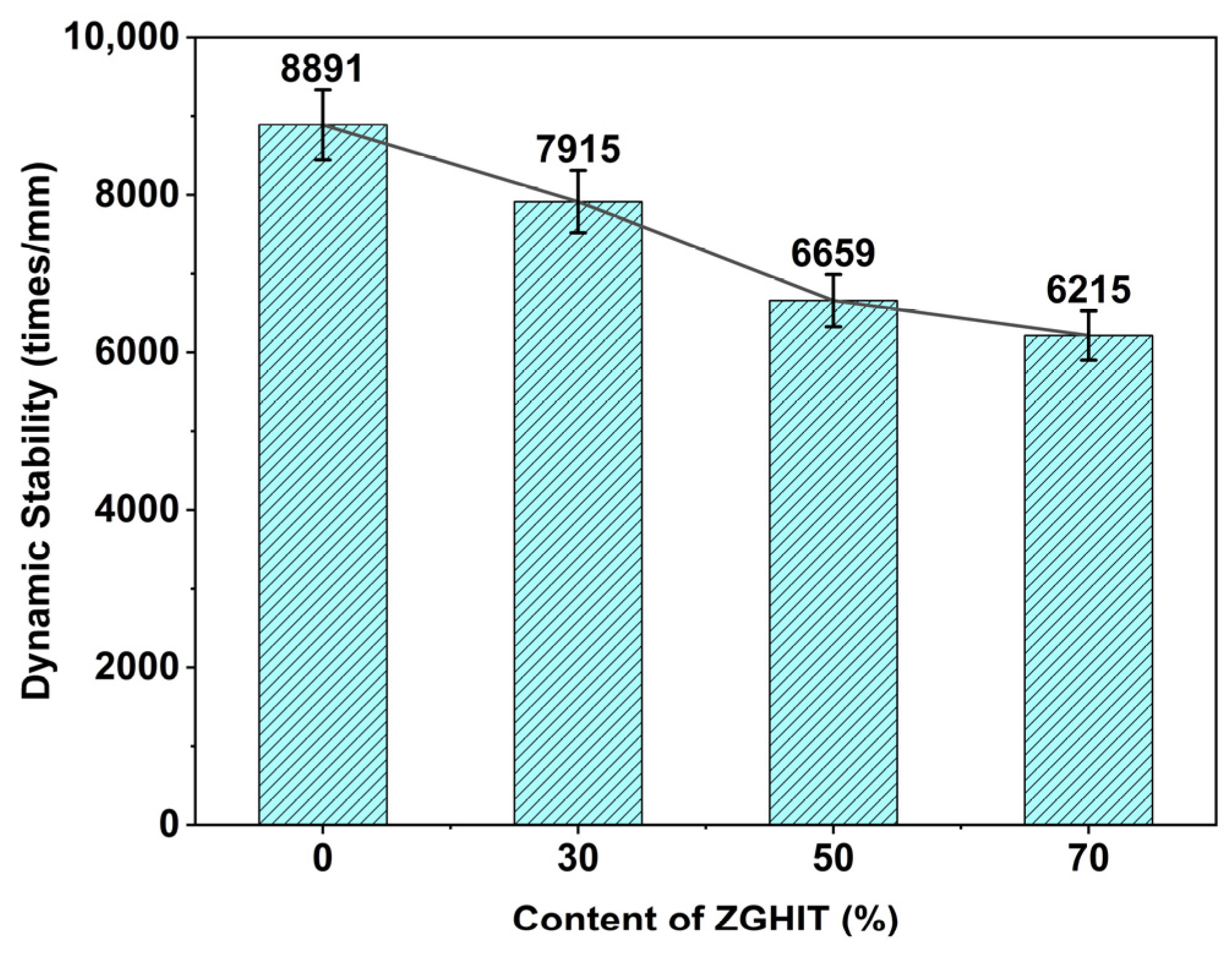
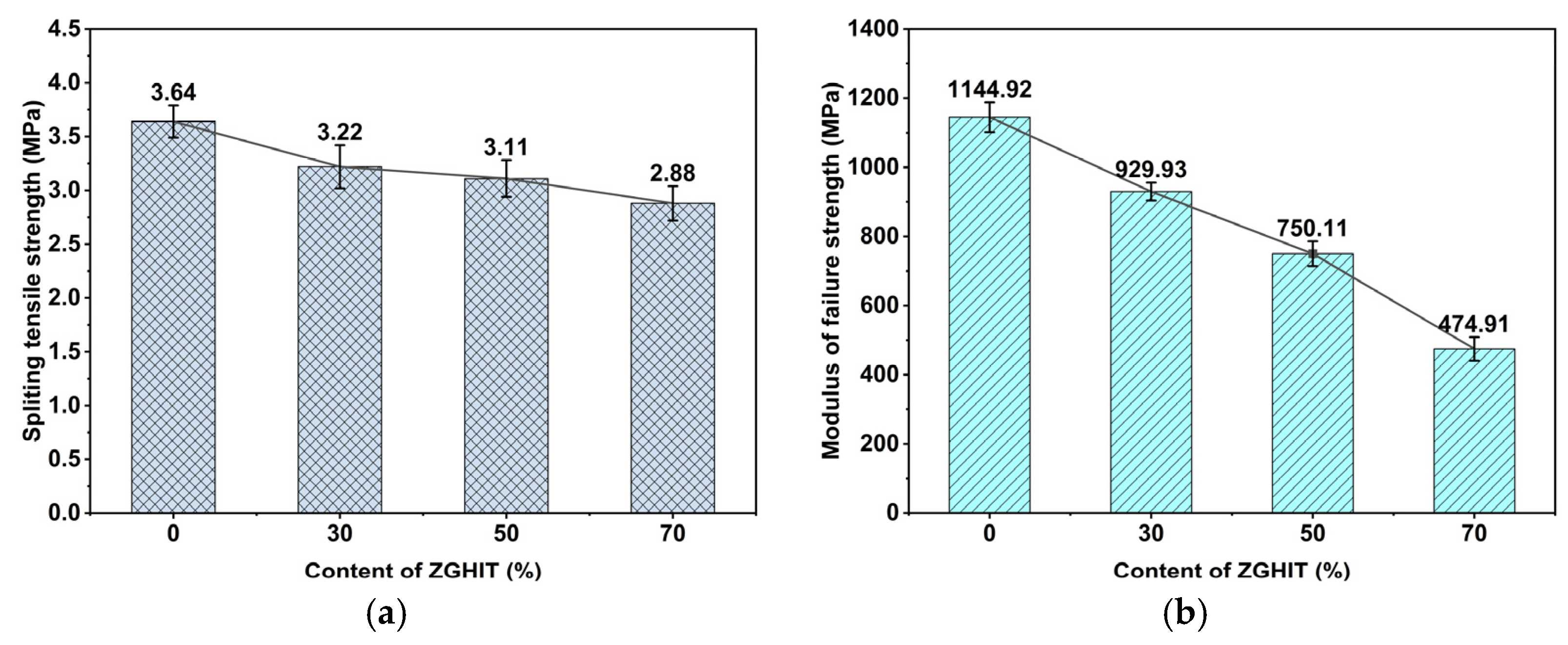
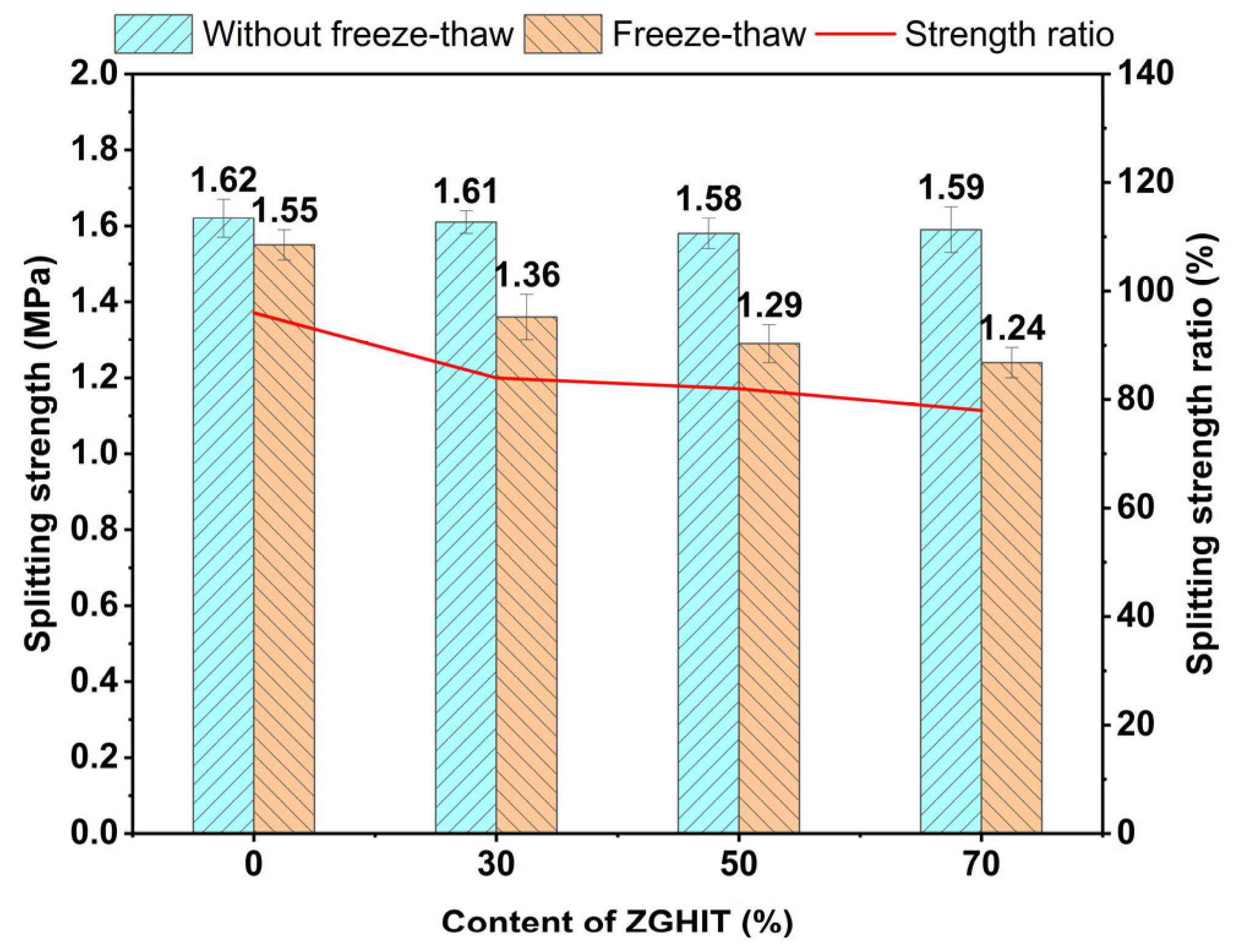
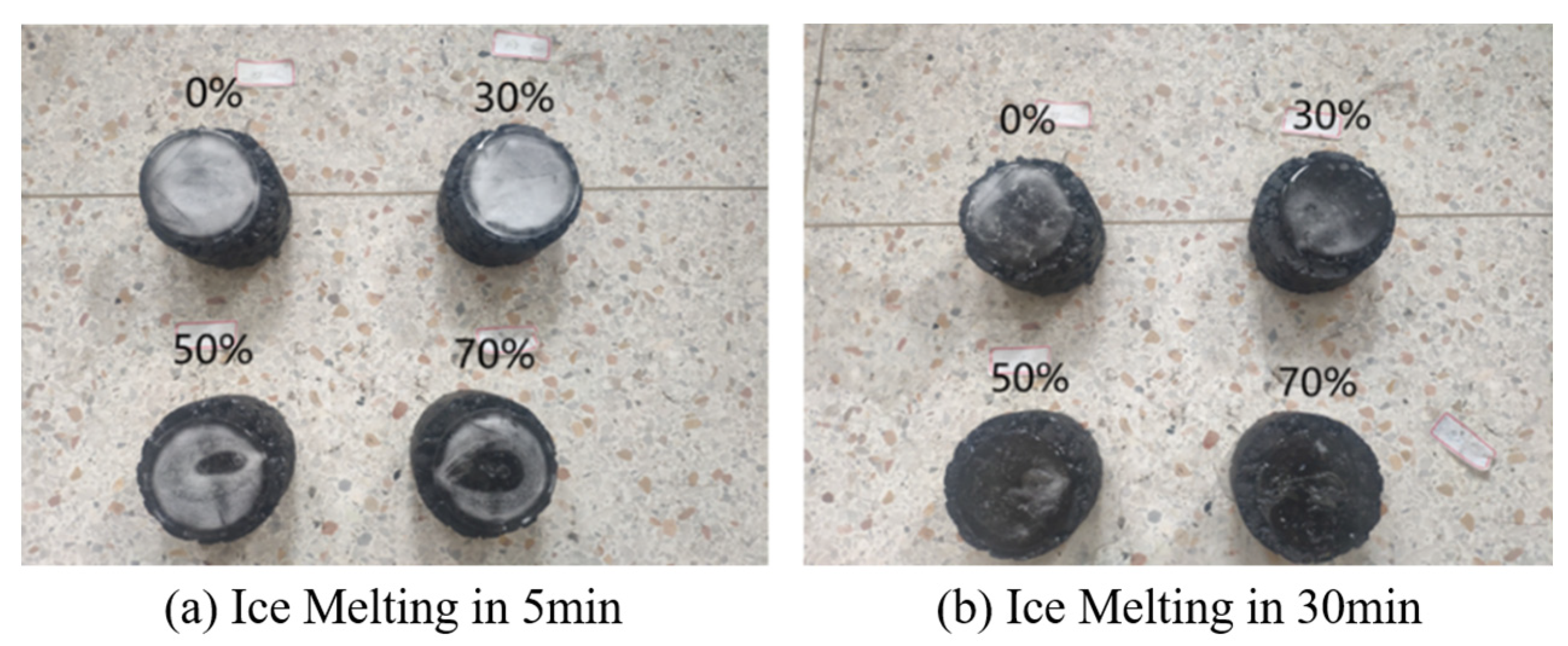
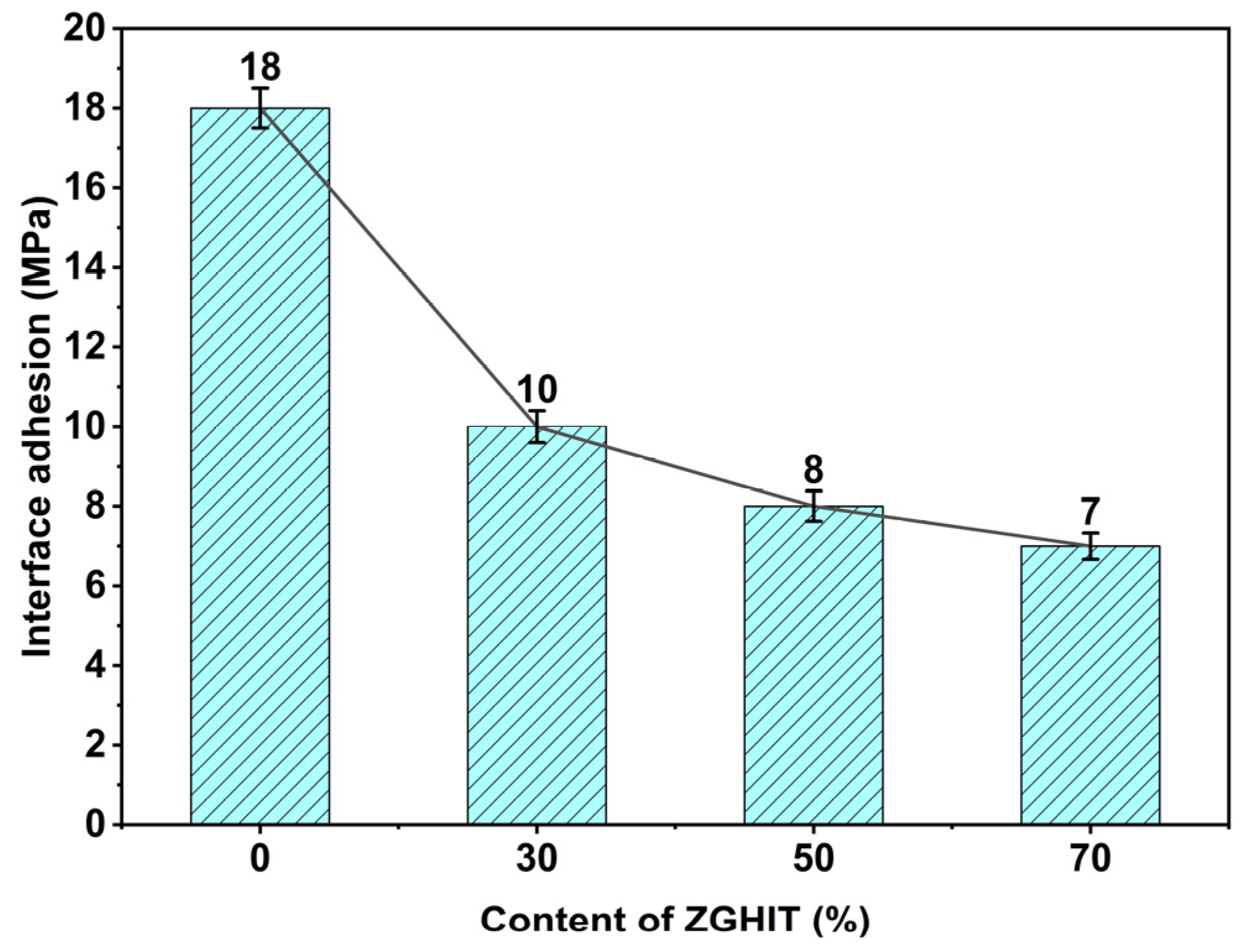
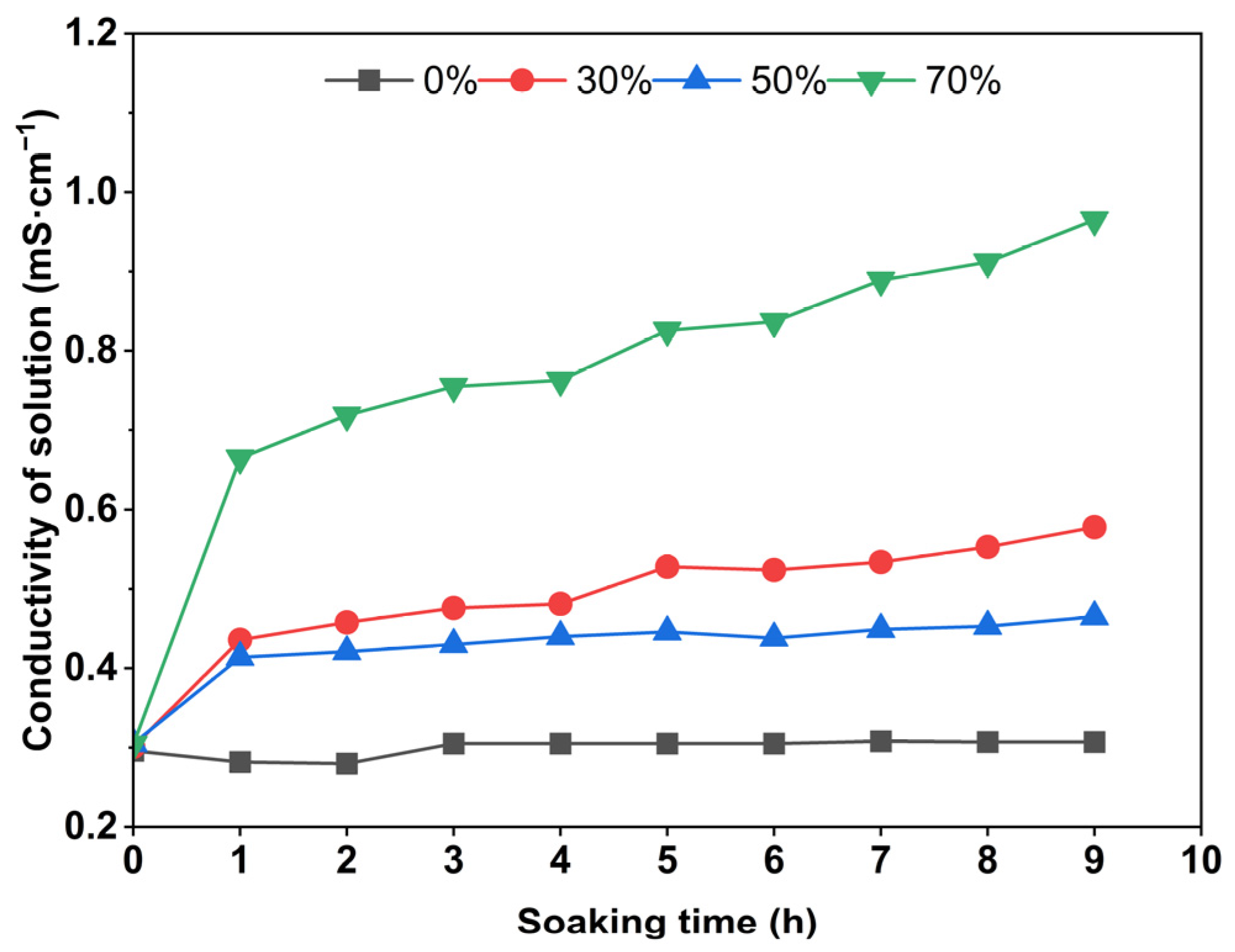
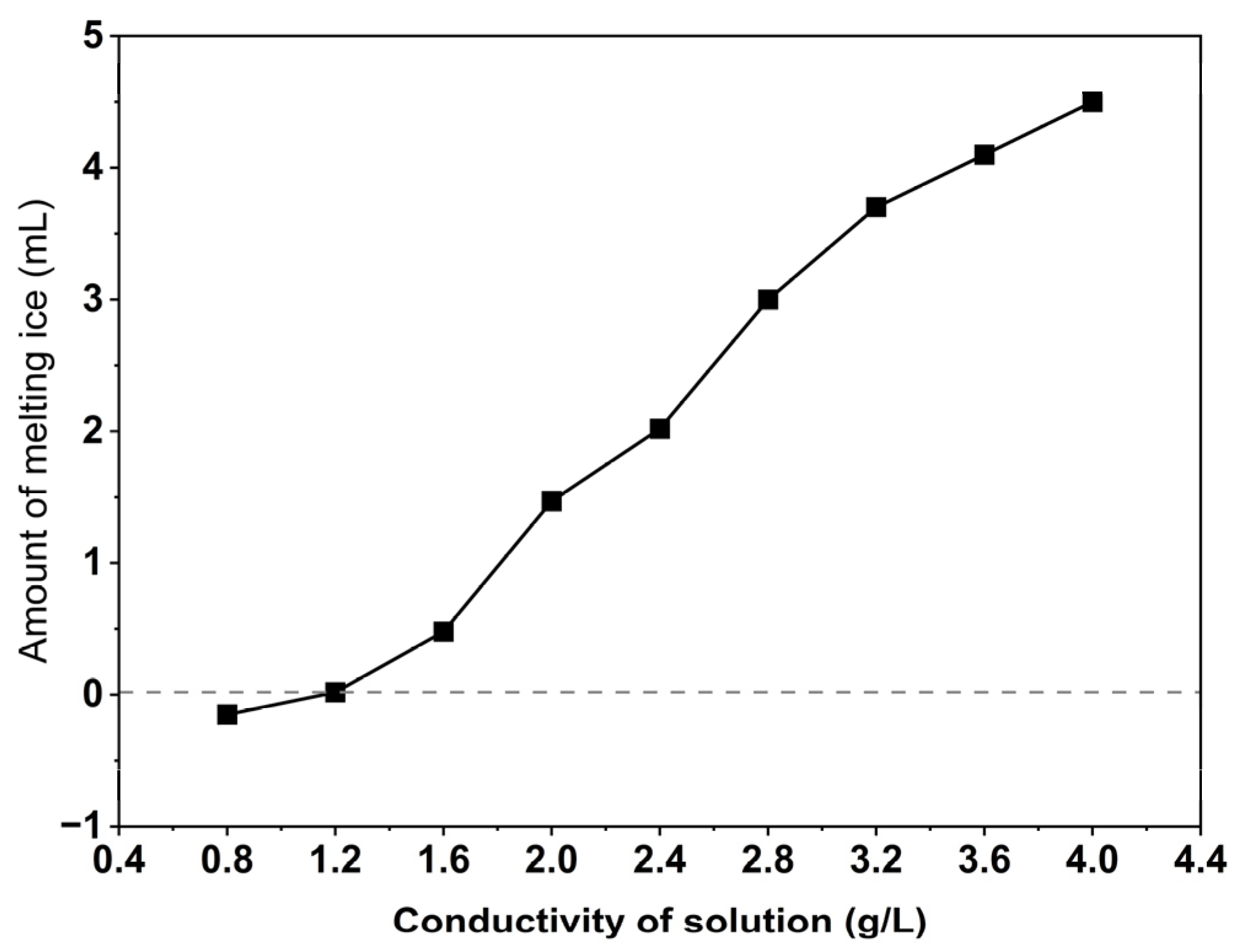
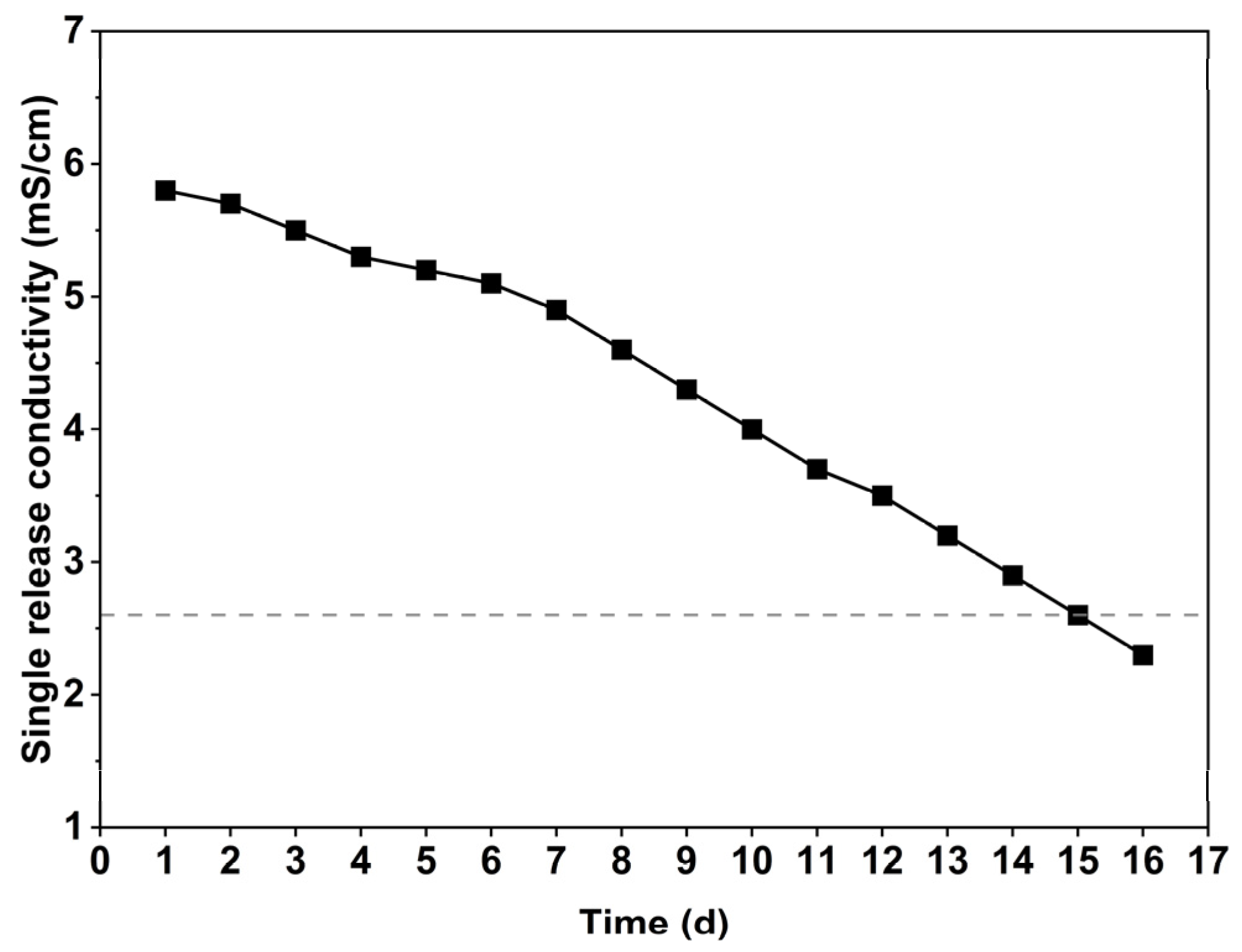
| Test Items | Unit | Test Value | Requirements |
|---|---|---|---|
| Penetration (25 °C,100 g, 5 s) | 0.1 mm | 63 | 40–80 |
| Ductility (5 °C, 5 cm/min) | cm | 34.2 | ≥20 |
| Softening point | °C | 74.5 | ≥60 |
| Flash point | °C | 304 | ≥230 |
| Elastic recovery (25 °C) | % | 80 | ≥75 |
| Rolling thin film ovens test (RTFOT) | |||
| Quality variation | % | 0.3 | ≤±1.0 |
| Penetration ratio (25 °C) | % | 76 | ≥65 |
| Ductility (5 °C) | cm | 23 | ≥15 |
| Aggregates | 9–16 mm | 4.75–9.5 mm | 2.36–4.75 mm | 0–2.36 mm | Requirements |
|---|---|---|---|---|---|
| Apparent specific gravity | 2.862 | 2.879 | 2.846 | 2.787 | ≥2.60 |
| Bulk specific gravity | 2.713 | 2.722 | 2.709 | 2.683 | ≥2.50 |
| Water absorption (%) | 0.49 | 0.53 | 0.55 | 1.89 | ≤2.0 |
| Content of ZGHIT (%) | MS_1 (kN) | MS_2 (kN) | Residual Stability (%) | MS_3 (kN) | Residual Stability (%) |
|---|---|---|---|---|---|
| 0 | 16.63 | 16.15 | 97.11 | 13.88 | 88.46 |
| 30 | 12.76 | 15.59 | 122.18 | 8.35 | 65.43 |
| 50 | 12.62 | 15.20 | 120.44 | 7.26 | 57.52 |
| 70 | 11.81 | 14.11 | 111.95 | 6.67 | 56.48 |
| Time (min) | 0 | 10 | 20 | 30 | 40 | 50 | |
|---|---|---|---|---|---|---|---|
| Content of ZGHIT (%) | 0 | 0 | 2.10% | 7.14% | 12.39% | 15.34% | 18.28% |
| 30 | 0 | 10.17% | 21.58% | 34.85% | 43.57% | 55.39% | |
| 50 | 0 | 15.89% | 29.66% | 47.25% | 62.71% | 79.24% | |
| 70 | 0 | 21.26% | 44.03% | 63.34% | 86.55% | 100.00% | |
| Region | Average Annual Rainfall (mm) | Conversion of Average Annual Rainfall (mL) | Durability Prediction (Year) |
|---|---|---|---|
| Heilongjiang | 753.1 | 1250.9 | 7.46 |
| Beijing | 644.2 | 1031.4 | 7.59 |
| Shaanxi | 740.4 | 1185.7 | 7.59 |
| Jiangsu | 1090.7 | 1746.8 | 5.15 |
Disclaimer/Publisher’s Note: The statements, opinions and data contained in all publications are solely those of the individual author(s) and contributor(s) and not of MDPI and/or the editor(s). MDPI and/or the editor(s) disclaim responsibility for any injury to people or property resulting from any ideas, methods, instructions or products referred to in the content. |
© 2023 by the authors. Licensee MDPI, Basel, Switzerland. This article is an open access article distributed under the terms and conditions of the Creative Commons Attribution (CC BY) license (https://creativecommons.org/licenses/by/4.0/).
Share and Cite
Zhang, J.; Wang, W.; Liu, J.; Wang, S.; Qin, X.; Yu, B. Pavement Performance and Ice-Melting Characteristics of Asphalt Mixtures Incorporating Slow-Release Deicing Agent. Buildings 2023, 13, 306. https://doi.org/10.3390/buildings13020306
Zhang J, Wang W, Liu J, Wang S, Qin X, Yu B. Pavement Performance and Ice-Melting Characteristics of Asphalt Mixtures Incorporating Slow-Release Deicing Agent. Buildings. 2023; 13(2):306. https://doi.org/10.3390/buildings13020306
Chicago/Turabian StyleZhang, Jiaqiang, Weicheng Wang, Jinzhou Liu, Shuyi Wang, Xiaochun Qin, and Bin Yu. 2023. "Pavement Performance and Ice-Melting Characteristics of Asphalt Mixtures Incorporating Slow-Release Deicing Agent" Buildings 13, no. 2: 306. https://doi.org/10.3390/buildings13020306
APA StyleZhang, J., Wang, W., Liu, J., Wang, S., Qin, X., & Yu, B. (2023). Pavement Performance and Ice-Melting Characteristics of Asphalt Mixtures Incorporating Slow-Release Deicing Agent. Buildings, 13(2), 306. https://doi.org/10.3390/buildings13020306








